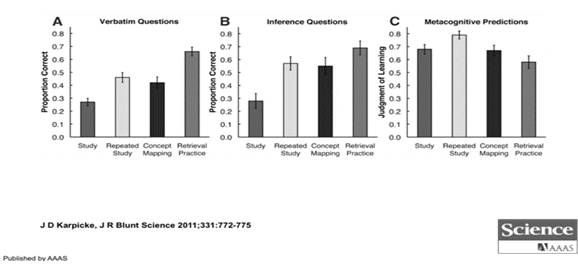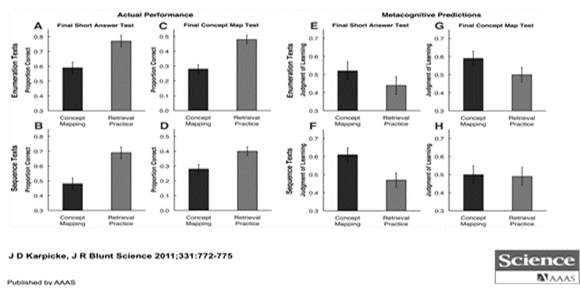The New Science of Learning and Why Students Forget Their Economics So Quickly
Donald T. Wargo and Olga Vilceanu, Temple University Published June 2011
(Adapted from a paper presented at the AEA National Conference on Teaching Economics, Stanford University, June 1-3, 2011. For a full copy of the paper, e-mail the author.)
The New Science of Learning
Studies of learning development, human brain plasticity, and computational approaches to learning are contributing to new understandings of how we learn and how we form long-term memories (Metltzoff et al. 2009). Four critical findings inform the revisions we have made to our teaching protocol:
(1) Learning is computational and probabilistic, using Bayesian Logic. Humans are born with computational skills used to infer language structure, cause and effect, as well as basic statistical regularities and co-variations. This Bayesian model of probabilistic thinking challenges both Skinnerian reinforcement learning and Chomsky’s “nativist” model of an inborn facility for grammar and syntax (Gopnik 2004). In early childhood, humans learn actively, testing their environment through observation, hypothesizing, experimentation, conclusion, and incorporation of feedback.
(2) Learning is fundamentally social is nature. Parents, peers, and teachers offer social cues about what and when to learn, in formal and informal learning environments. Interpersonal interaction among students at any age increases the quality and amount of learning. In instances where tutoring involves active learning strategies, students test up to two standard deviations above classroom teaching limited to passive learning strategies (Meltzoff et al. 2009).
Benjamin Bloom (“Bloom’s Taxonomy”) calls this the “2 Sigma Problem”. The goal is to create teaching/learning conditions under large group instruction that allow the individual student to achieve the same level they would under individual instruction by a skilled tutor (Bloom 1984; Guskey 2007).
(3) Designated brain circuits link perception and action. The same “mirror neurons” that allow readers and television viewers to identify and share an emotional connection with characters by entering a state of “suspended disbelief” are activated in real life. Damasio and Meyer (2008) demonstrated that both acting yourself or watching others act has the same effect on the brain and activates the same areas of the brain. In addition, active learning produces faster and more satisfying results through imitation, shared attention, and prompting of empathic understanding.
(4) The hippocampus, primarily during rapid-eye movement sleep (“REM sleep”), processes memories and sends them to varied and specific parts of the brain for long-term storage. Multiple retrieval and strong emotional content strengthen the path to long-term memory. As a matter of fact, they are conditions precedent for and the only two reasons the brain creates long-term memories. All other information in the short- term memory is deleted during sleep. Furthermore, the neurotransmitter that controls the persistence of long-term memory is dopamine, the brain’s “reward chemical” which motivates us to seek things we view as rewarding (Rossato et al. 2009; Shen et al. 2008). Finally, long-term memories do not actually exist in any one place in the brain, but are actually systems of neurons connected together. (Neuroscientists say, “Neurons that fire together, wire together”.) Each time we call up a memory, it must be “reconsolidated” by the brain, that is, reconstructed into a gestalt. Multiple retrieval strengthens these long-term memories.
Empirical Evidence
Field experiments have underscored the validity of the above findings. To improve the quality of long-term memory, encoding should be an elaborate process, engaging multiple parts of the brain, much like a multimedia presentation. Elaborative learning activities are central to contemporary education and one of the most highly regarded forms is “concept mapping” (Novak 2005; Nesbitt and Adescope 2006). In concept mapping, students construct a diagram in which nodes are used to represent concepts and links connecting the nodes represent relations among the concepts.
More importantly, the recent groundbreaking work of Jeffrey Karpicke and colleagues (Karpecke et al. 2007, 2008, 2010, 2011) has shown that repeated practice in retrieval of information produces significantly more learning than either repeated study or elaborative study using concept mapping. In Karpicke’s most recent experiments (2011), he and his colleagues had undergraduate students study a science text under four conditions. The first condition was a single study session. The second group studied the text in four consecutive study sessions. The third group was taught concept mapping and, following the initial study period, used it to create a concept map while viewing the text. The final group studied the text and then practiced retrieval in a free recall test. The last group did this multiple times, but the total time period for the processes in each case was the same. The results of this first experiment, assessed a week later by both verbatim questions and inference questions, are below.
Figure 1: Results of Experiment 1

(The experimenters also asked the student to predict which method they thought would enable them to learn best, and these results are shown in graph C above.)
To further test the robustness of their results, the experimenters then used two different types of science texts, one that simply describe a list of concepts (“enumerative text”) and a second text that described a continuous and ordered series of events in a process (“sequence text”). The subjects (N = 120) were divided into those that did concept mapping and those that did retrieval practice. One week later, the students were randomly divided into a first group that took a short answer test and a second group that created concept maps in the exam. The results are shown below. Surprisingly, even those that did not study by concept mapping did better in the concept-mapping exam than those who studied by concept mapping.
Figure 2: Results of Experiment 2

The most rigorous, comprehensive and compelling research in this area is the work of Haak et al. (2011). These authors worked with a large number of introductory biology classes at the University of Washington that contained hundreds of students – some classes had 700 students. They compared three teaching protocols: 1) standard lecture format; 2) a “Moderate-Structure Class” that involved lectures, a few daily multiple choice “clicker” questions and a peer-graded five question weekly exam; 3) a “High-Structure Class” with no lectures, but all active learning in the form of pre-class reading, pre-class quizzes, extensive informal group work in class and a weekly peer-graded practice exam. The moderate-structure class, as expected and predicted by other research, increased performance in all students over the lecture-based class. Even more compelling, however are the results of the high-structure class. This learning protocol increased all student performance over the moderate protocol but also decreased the achievement gap between non-disadvantaged students and disadvantaged students by forty-five percent!
Opportunities for Multiple Retrieval and Deliberative Practice
Combining the new science of learning with research on brain biology reinforced the author’s determination to change teaching in ways that improved student learning. While these strategies are not specific to teaching economics courses, they were nonetheless applied and tested in sections of Microeconomics, Macroeconomics and Economics for Life.
The most significant changes we have made to our teaching protocol. We use numerous methods to cause students to engage in multiple retrieval and deliberative practice. First, students must do on-line homework for each chapter (Myeconlab). Next, we have four exams instead of two in the semester. They are administered according to the logical grouping of chapters in the textbook. One action we think is important for student review is that the students hand in an answer sheet and leave the exam taking the exam with them and a copy of the correct answers so that they will review the material (which they do immediately). Further, we offer two extra credit exams after the material covered in a mid-term for the most important chapters in the book. These are take-home, open book and students are allowed to work in teams (Each student hands in his own answer sheet). Students receive two points added to their final grade if they score 80% or better on the extra credit exam. Prior to every exam, we have a workshop in class during which students work in groups of two on a practice mid-term exam. Also, the Teaching Assistant holds a review session outside of class before each exam.
Further, we post all our Power Point Presentations on-line on Blackboard and use Class Capture to post streaming videos of every lecture on Blackboard. It is clear to us that students take advantage of this material for review.
As a result of these changes, not only did the distribution of student grades narrow, but the authors’ student evaluations increased substantially.
References
Bloom, B. S. 1984. The 2 Sigma Problem: The Search for Methods of Group Instruction as Effective as One-to-One Tutoring. Educational Researcher 13 (6): 4. JSTOR 1175554
Damasio, A. and K. Meyer 2008. Behind the looking–glass. Nature 454 (10 July 2008). https://doi.org/10.1038/454167a
Gopnik, A., D. Danks, C. Glymour, T. Kushnir, L. E. Schulz and D. M. Sobel 2004. A Theory of Causal Learning in Children: Causal Maps and Bayes Nets. Psychological Review 111 (1): 3. https://doi.org/10.1037/0033-295X.111.1.3 (In Carnegie Mellon University repository)
Guskey, T. R. 2007. Formative classroom assessment and Benjamin S. Bloom. Journal of Adv. Acad. 19 (8). ERIC ED490412
Hack, D. C., J. HilleRisLambers, E. Pitre and S. Freeman 2011. Increased Structure and Active Learning Reduce the Achievement Gap in Introductory Biology. Science 332: 1213-121 https://doi.org/10.1126/science.1204820
Karpicke, D. and H. L. Roediger III. 2007. Repeated retrieval during learning is the key to long-term retention. J. Memory and Language 57: 151. https://doi.org/10.1016/j.jml.2006.09.004
Karpicke, J. D. and H. L. Roediger 2008. The Critical Importance of Retrieval for Learning. Science 319: 966. https://doi.org/10.1126/science.1152408
Karpicke, J. D and F. M. Zaromb 2010. Retrieval mode distinguishes the testing effect from the generation effect. J. Memory and Language 62: 227. https://doi.org/10.1016/j.jml.2009.11.010
Karpicke, J. D. and H. L. Roediger 2010. Is expanding retrieval a superior method for learning text materials? Memory and Cognition 38: 116. https://doi.org/10.3758/MC.38.1.116
Karpicke, J. D. and J. R. Blunt 2011. Retrieval Practice Produces More Learning than Elaborative Studying with Concept Mapping. Science 331 (6018): 772–775. https://doi.org/10.1126/science.1199327
Metltzoff, A., P. K. Kuhl, J. Movellan and T. J. Sejnowski 2009. Foundations for a New Science of Learning. Science 325 (5938): 284. Blackwell Publishing Ltd https://doi.org/10.1126/science.1175626
Nesbit. J. C. and O. O. Adesope 2006. Learning With Concept and Knowledge Maps: A Meta-Analysis. Review of Educational Research 76, (3): 413–448. https://doi.org/10.3102/00346543076003413
Novak, J. D. 2005. Results and Implications of a 12-Year Longitudinal Study of Science Concept Learning. Research in Science Education 35: 23–40. https://doi.org/10.1007/s11165-004-3431-4
Rossato, J. I., L. Bevilaqua, I. Izquierdo, J. Median and M. Cammarota 2009. Dopamine Controls Persistence of Long-Term Memory Storage. Science 325 (21): 101. https://doi.org/10.1126/science.1172545
Shen, W., Flajolet, M., Greengard, P., and D. J. Surmier 2008. Dichotomous Dopaminergic Control of Striatal Synaptic Plasticity. Science 321: 848–854. https://doi.org/10.1126/science.1160575

